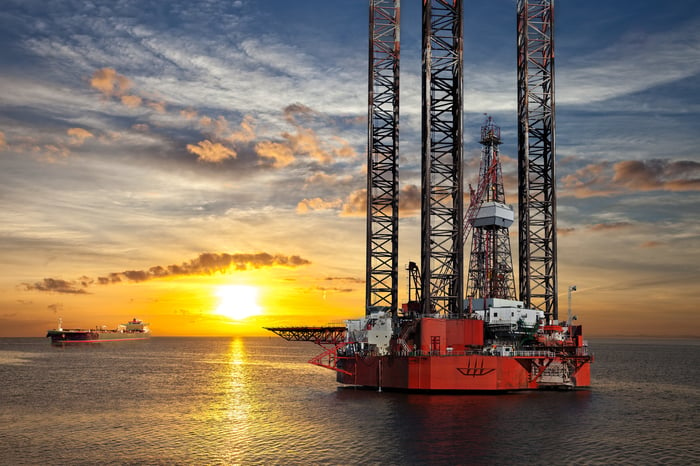Last month was a rough one for oil giant ExxonMobil (XOM 1.15%). Its stock tumbled after reporting fourth-quarter results in early February -- enduring its worst day since 2011 -- a slide that continued the next day as investors dug in deeper into the report and began growing increasingly concerned that the ExxonMobil was falling behind its peers. By the end of the month, shares of the oil giant had tumbled 15%, wiping a stunning $60 billion off its market cap.
One of ExxonMobil's issues is that it hasn't invested enough money developing projects to offset the natural decline rate of its legacy oil fields. As a result, output dropped 3% last quarter to 3.98 million barrels of oil equivalent per day (BOE/D). It's a problem the company plans to address in the coming years by ramping up its investment spending, which could boost output 1 million BOE/D by 2025. While impatient investors might want ExxonMobil to pursue a quick fix like making a needle-moving acquisition, that likely wouldn't pay off as much as its current strategy in the coming years.

Image source: Getty Images.
The long-term plan
In response to its weak fourth-quarter results, ExxonMobil outlined an aggressive growth plan earlier this month that would double earnings and cash flow by 2025. It intends on getting there by significantly ramping up its investments, calling for $24 billion in capital spending this year, which should rise to $28 billion in 2019 before averaging about $30 billion annually from 2023 to 2025. That increase in spending was "the price you pay for cash flow," according to CEO Darren Woods, who further noted that every $1 ExxonMobil spent on capital expenses over the past decade produced $1.20 in operating cash flow. That plan would put the company on pace to generate more than $60 billion in annual operating cash flow by 2025, assuming $50 oil.
While ExxonMobil expects several resource plays to fuel that growth, two will drive the bulk of its strategy. First, the company anticipates a fivefold increase in output from its Permian Basin resource through 2025. One of the catalysts of that growth is last year's $6.6 billion purchase of Bass, which gives the company access to more than 4,800 high-return drilling locations in the region. The other main fuel is the oil giant's massive offshore resource discovery in Guyana. ExxonMobil expects the first phase of that find to come online by 2020, with further ones powering growth through 2025.

Image source: Getty Images.
Contrasting the alternative
ExxonMobil's strategy would see it spend an astonishing $230 billion over the next eight years to add about $30 billion to annual cash flow, assuming $50 oil. That's about a 13% yield on that investment, though as Woods pointed out, the company could ultimately earn a total return of 120% on that outlay. For comparison's sake, an alternative option to grow cash flow would be to make a significant acquisition. Given ExxonMobil's size and balance sheet strength, it could go in almost any direction, though the following three oil companies stand out given their ability to produce gobs of cash flow right now.
If ExxonMobil wanted to move the needle quickly, U.S. oil giant ConocoPhillips (COP 1.23%) would be a prime target considering it has an enterprise value of nearly $73 billion. While that represents a hefty price tag, ConocoPhillips would provide an immediate cash flow boost since it produced $7.1 billion last year when oil averaged $50 a barrel. Though to put that into perspective, it's a less-than-10% cash flow yield on the purchase price, and that's without any deal premium or financing costs, suggesting this prospective purchase wouldn't earn ExxonMobil as high a return as its capital program could.
The company would face a similar issue if it bought EOG Resources (EOG 1.07%), which currently has a $64 billion price tag. For a company that's on pace to produce more than $6 billion in cash flow this year at $50 oil, that too represents a less-than-10% return. Anadarko Petroleum (APC), meanwhile, has a current value of $44.5 billion. While it's also a cash flow machine and can produce $4.6 billion at $50 oil this year, that's only a slightly more than 10% return if ExxonMobil gobbled it up. However, it is worth noting that all three are on pace to produce much more cash this year at current oil prices, with EOG expecting to generate more than $1.5 billion in free cash flow while Anadarko's on pace for at least $1 billion in excess cash this year. However, ExxonMobil's plan would also generate more at that oil price. In other words, the company would likely create the most value with its current strategy of investing in high-return expansion projects than by making a large acquisition.
The right strategy for the long haul
ExxonMobil doesn't need to make an acquisition to create value for investors since it can invest in its resource base and double its cash flow in eight years, and likely earn a higher return in the process. While that strategy requires more patience from investors, in time that plan should make the company's recent stumble seem like a distant memory.





